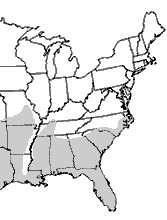Pigmy Rattlesnake (Sistrurus miliarius) – Venomous



Photos by Amanda Hurst unless otherwise noted
Description: This small — 14�22 in (38-56 cm) — rattlesnake belongs to the genus Sistrurus and is commonly referred to as a pigmy rattler or ground rattler. Unlike the larger rattlesnakes of the genus Crotalus, this species has nine large scales on top of the head and a tiny rattle that can seldom be heard. There are three subspecies of pigmy rattlesnakes, of which two occur in Georgia (Sistrurus miliarius miliarius – the Carolina pigmy rattler and Sistrurus miliarius barbouri – the dusky pigmy rattler). Both subspecies have a row of mid-dorsal spots and a bar than runs from the eye to the base of the mouth, but the color of this bar can vary from black to brownish red. An orange or reddish brown dorsal stripe is also present on both subspecies. In young snakes, the tip of the tail is sulfur yellow and is used for caudal luring. The Carolina pigmy rattler can be gray, tan, or lavender. Some specimens from northern Georgia and eastern North Carolina are orange or red. The pattern of this subspecies is usually clean and well defined, with one or two rows of lateral spots. The venter is moderately patterned. The dusky pigmy ranges from bluish gray to nearly black. Numerous dark flecks often obscure the pattern of this subspecies. There are normally three rows of lateral spots, and the venter is heavily patterned.
Range and Habitat: The Carolina pigmy rattler is found in the northeastern, northwestern, and central portion of Georgia and throughout South Carolina. Dusky pigmy rattlers inhabits the southern Coastal Plain area. Although fairly common in the Coastal Plain of both states, populations in the Piedmont are few and scattered. Dusky pygmies inhabit areas near water sources like creeks, marshes, and swamps but can be found in a variety of habitats including pine and scrub oak sandhills, scrub pinewoods, mixed forests of pine and hardwoods, longleaf pine-wiregrass forests, swamps, and even xeric uplands. Carolina pigmies are generally restricted to drier habitats and are most common in sandhills and xeric pine forests. When available, this species is known to use gopher tortoise (Gopherus polyphemus) burrows as well as those of small mammals.
Habits: Pigmy rattlesnakes spend most of their time well-hidden among leaf litter and can be very hard to spot. From such hiding places they ambush a variety of prey including lizards, frogs, small mammals, and insects as well as centipedes. These snakes are most often encountered crossing roads on summer evenings. Females give birth to live young in the late summer or fall.
Conservation Status: This species is not protected by South Carolina or Georgia state law, but pigmy rattlesnakes are protected in North Carolina and Tennessee.
Pertinent References:
Gibbons, W., and Dorcas, M. 2015. Snakes of the southeast. University of Georgia Press.
May, P. G., T. M. Farrell, S. T. Heulett, M. A. Pilgrim, L. A. Bishop, D. J. Spence, A. M. Rabatsky, M. G. Campbell, A. D. Aycrigg, and W. E. Richardson. 1996. The seasonal abundance and activity of a rattlesnake (Sistrurus miliarius barbouri) in central Florida. Copeia 1996:389-401.
Roth, E. D., P. G. May, and T. M. Farrell. 1999. Pigmy rattlesnakes use frog-derived chemical cues to select foraging sites. Copeia 1999:772-774.
Account Author: Austin Meadows, University of Georgia � revised by J.D. Willson
